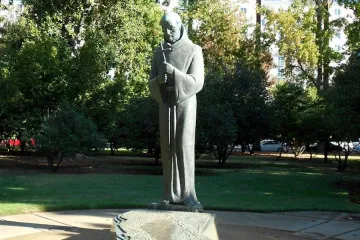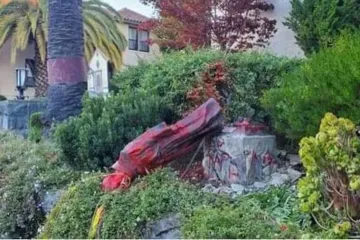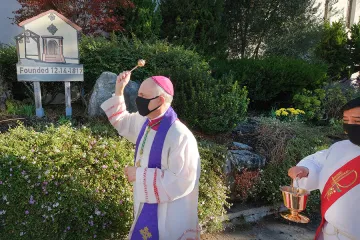Washington D.C., Sep 13, 2021 / 12:04 pm
A California bill to replace a statue of St. Junipero Serra at the state capitol unfairly slanders the saint’s legacy, two archbishops claimed in a Wall Street Journal op-ed published Sunday, Sept. 12.
Last month, California lawmakers voted overwhelmingly to pass Assembly Bill 338, which would replace the statue of St. Junipero Serra at the state capitol with one honoring local Indigenous populations. The bill text claims that Serra and his missions were responsible for a host of atrocities against native peoples.
Serra was canonized by Pope Francis in 2015, becoming the first saint to be canonized on American soil. A Franciscan friar from Spain, he left a prestigious university chair in Majorca for what is now the United States in 1749, founding a system of missions to evangelize the Indigenous in modern-day California. He celebrated more than 6,000 baptisms and 5,000 confirmations.
The bill text states that “[Indigenous] history and contributions have been relatively ignored, written with great discrepancies and false mythologies.”
“One of the greatest gaps between history and reality has been the retelling of the mission period in Native American history and the role of Franciscan friar Junípero Serra,” the bill states, claiming that Serra oversaw the mission system which included “Enslavement of both adults and children, mutilation, genocide, and assault on women.”
These claims about Serra are false, said Archbishops Jose Gomez of Los Angeles and Salvatore Cordileone of San Francisco, in their op-ed.
“While there is much to criticize from this period, no serious historian has ever made such outrageous claims about Serra or the mission system, the network of 21 communities that Franciscans established along the California coast to evangelize native people,” they wrote.
The archbishops wrote that the lawmakers drew from “a single tendentious book written by journalist Elias Castillo.” That book, “A Cross of Thorns: The Enslavement of California’s Indians by the Spanish Missions,” is cited in the bill as “a more accurate and complete account of the period.”
“As leaders of the state’s two largest Catholic communities, we serve thousands of native Californians who trace their faith to ancestors who helped build the missions,” they said. “We understand the bitter history of native exploitation. But history can be complicated and facts matter.”
The archbishops described Serra as a “complex character,” but one who “defended indigenous people’s humanity, decried the abuse of indigenous women, and argued against imposing the death penalty on natives who had burned down a mission and murdered one of his friends.”
Serra, the archbishops noted, traveled 2,000 miles to Mexico City when he was aged and infirm “to demand that authorities adopt a native bill of rights he had written.”
“Mr. Newsom knows California history well enough to see that the claims against Serra aren’t true,” they said. “In 2019 he apologized for the state’s history of injustice against native people, acknowledging that it was California’s first governor, Peter Burnett, who launched what Burnett called ‘a war of extermination.’”
That “war of extermination,” the archbishops pointed out, began more than 60 years after Serra had died.
“The destruction of the state’s native people happened long after he was gone and many of the missions had been taken over by the government,” they said.
The statue of St. Junipero Serra was toppled by protesters in June 2020, and has since been in a storage area. Instead of replacing the statue, however, the archbishops proposed adding an additional statue at the capitol to honor the state’s Indigenous populations.
“How we choose to remember the past shapes the people we hope to be in the future,” they said. “We can think of no better symbol for this multiethnic state committed to human dignity and equality than to place two statues at the California Capitol—one celebrating the living heritage of California’s indigenous peoples, another reflecting the faith and leadership of their defender St. Junípero Serra.”
(Story continues below)






